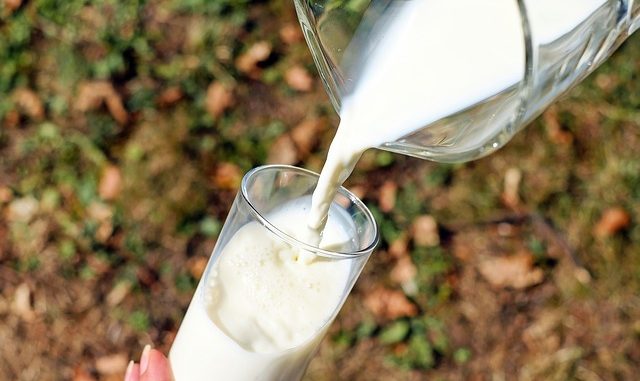
Milk, where would we be as humans without it? It is the food which exclusively sustains all of us in the first few months of our life.
Raw milk is a lacteal secretion which is not the same as colostrum. All milk is obtained by milking cows and can be turned into a variety of foodstuffs which have been exploited for millennia.
Composition
Milk is mainly water, between 87 and 88 per cent weight.
It contains carbohydrates of about 5 per cent weight which are mainly lactose. This is often converted to lactic acid during bacteria fermentation. It is an important by-product in the production of yogurt and other fermented milk drinks. The remainder is protein, fat and some salt.
When milk is heated lactose is converted to the slightly sweeter sugar, lactulose. This sweetness is the main contributor to flavour in condensed milk.
Fat is a major constituent. It forms about 3 to 4 per cent by weight of whole milk.
Dissolved in the fat components are fat soluble vitamins such as A,D,E and K. Pigments such as carotenes and xanthophylls are present. It also contains cholesterol and phospholipids as well as triglycerides. The triglycerides make up 95 per cent by weight of fat.
Milk Fat Globules (MFG)
Natural milk fat globules in milk have different sizes but range from 0.2 microns to 10 microns in diameter. The mean diameter of all these globules is 4 microns.
The number of smaller droplets far exceeds the larger ones. These larger ones though contribute most of the fat however.
All these fat globules exist in colloidal assemblies made up of mainly the lipids. A globule has a triacyglycerol core surrounded by a membrane composed of a trilayer of phospholipids, cholesterol and various proteins. The membrane layer is referred to as the milk fat globule membrane (MFGM).
The MFGM is composed of phosphatidylcholine (PC), phosphatidylethanolamine (PE), phosphatidylserine (PS) and phosphatidylinositol (PI). There are also sphingolipids such as sphingomyelin (SM) and glycosphingolipids such as cerebrosides and gangliosides.
Milk As An Emulsion
Milk in the structural sense is a wonderful example of a naturally occurring emulsion. The fat of which there is about 3.5% by weight is emulsified. This fat emulsion is stabilised in a complex protein membrane system known as the milk fat globule membrane.
Cream And Creaming
Whilst fresh milk appears as white, opaque and homogenous, if you leave it to stand, it soon develops a thicker white and creamy top layer. This phenomenon takes but a few hours.
There is a significant density difference between milk fat and the watery, aqueous phase. Fat droplets tend to rise to form the cream layer because of this difference. The larger the fat droplet the greater the difference in density and the faster they tend to rise and form this separate cream layer. On rising to the surface, the droplets can either coalesce or cluster together. Larger fat globules are formed as a result. The creaming effect is even more pronounced as the larger fat particles come together.
The cream layer is still an emulsion and not a true separation between oil and water as some early researchers believed. The interfacial film remains intact. What has happened is the creation of concentrated emulsion overlaying a very dilute one.
The cream is usually removed for further concentration into double cream and for producing butter. The most common process for defatting milk so as to produce skimmed and semi-skimmed milk is to use a centrifugal separator.
Milk is often processed to stabilise the emulsion by homogenization. The fat globules are broken up into much smaller ones so that their density is very similar to the aqueous phase containing dissolved proteins etc. As a result the smaller fat globules simply remain dispersed.
The Flavour Of Milk
Milk flavour is bland but consumers are very sophisticated in their palette and can tell the difference between fresh and slight off-flavoured milk. The flavour of milk is a complex mix of many components which all contribute to differing degrees.
The main contributors are lactose which lends a slightly sweet taste, minerals contribute a slightly salty note and then the characteristic milky odours and flavours come for volatile short-chain fatty acids and sulphur compounds.
The flavour is also affected by consumption of other foodstuffs and is easily contaminated itself. If the cow eats feed which contains off-flavours too, these will be transferred to the milk where they are picked up by the consumer.
Off-flavours are also produced by chemical and biochemical reactions in the milk. Autooxidation is the main reaction of proteins and fats. The fats in milk are particularly prone to reactions such as oxidation. These are promoted by light, oxygen, enzymic action, heat and microbial activity.
To avoid forming off-flavours, the farmer and milk producer must monitor the type of feed, ensure collection and storage is correct, any processing is monitored and distribution is monitored.
Milk texture is another quality attribute. Full fat milk and cream have a rich and smooth mouthfeel due to the fat globules and droplets. Skimmed milk loses this creamy texture because the fat droplets are removed.
Proteins In Human And Cow’s Milk
There are key difference between human and cows milk.
Human milk is 60 per cent whey protein and 40 per cent casein. In cows this is almost round the other way with whey forming 20 per cent and casein forming 80 per cent of the protein. No wonder we can make cheese effectively from cow’s milk. Has anyone ever made human cheese from breast milk?
The main proteins in the whey fraction turn out to be alpha-lactabumin, beta-lactoglobulin, lactoferrin, secretory immunoglobulin A, a protein called osteopontin and a few others. These are found in both cows and human milk.
In the casein fraction it is mainly beta-casein with some kappa-casein. Casein is the main component of cheese. Casein is present in milk in the form of casein micelles. That is an important structure because it is one of the reasons why casein remains in solution in milk until rennet is added which causes its coagulation and precipitation.
If you take skimmed milk where much of the fat has been removed, the main dry solids are lactose and protein. There is a wide size discrepancy between the casein micelles and the remaining serum proteins. It is commercially possible to separate these two fractions using microfiltration which illustrates the point that there is an approximately 10 fold to 100-fold difference in diameter between these two major protein components (Walstra et al., 1999).
Alpha-lactalbumin is the main protein found in human milk. It is a single-chain polypetide containing 123 amino acids and is the main calcium-binding globulin. You can see why it has a vital function n human health. On the other hand beta-casein is the main component of human casein. This a phosphorylated protein which is found in micellar form. It has a relatively loose assembly and surprisingly little tertiary structure.
Milk regulations
In the United States, milk is defined in article no. 131.110 of the Code of Federal Regulations (US National Archives and Records Administration) as:
“the lacteal secretion, practically free of colostrum, obtained by the complete milking of one or more healthy cows. Milk in the final package for beverage use shall be pasteurised and shall contain not less than 8.25% milk solids not fat and not less than 3.25% milk fat. Milk may have been adjusted by separating part of the milk fat therefrom or by adding thereto cream, concentrated milk, dry whole milk, skim milk, concentrated skim milk or even nonfat dry milk. Milk may be homogenised. Optimal addition of Vitamin A and Vitamin D is allowed.”
Grade A milk, also called fluid grade milk, refers to milk produced under sufficiently sanitary conditions to qualify for fluid (beverage) consumption. Only Grade A milk is regulated under federal milk marketing orders.
Grade B milk (also referred to as manufacturing grade milk) does not meet fluid grade standards and can only be used in cheese, butter and nonfat dry milk. More than 90% of all milk produced nationally is Grade A, and much of the Grade A milk supply is used in manufactured dairy products.
The Grade A Pasteurized Milk Ordinance, published by the Food and Drug Administration, outlines minimum standards and requirements for Grade A milk production and processing. Grade A standards are recommended by the National Conference on Interstate Milk Shipments (NCIMS), which is composed of voting representatives from state and local regulatory agencies, and nonvoting representatives of the dairy industry and FDA. As a general rule, FDA accepts the Conference recommendations and incorporates them into the revised PMO. The state regulator (which is usually either the State Department of Agriculture or the State Health Department) adopts the PMO standards as a minimum, and in many cases requires more stringent standards.
References
Walstra, P. ed. (1999). Dairy Technology: Principles of Milk Properties and Processes. CRC Press. [Marcel Dekker Inc.]


Leave a Reply